
Rocks and Geology Around Las Vegas

Sedimentary Rocks, the most common rocks around Las Vegas, are formed by two very different processes.
First, sedimentary rocks can be formed when pre-existing rocks erode away and the resulting particles are cemented together again. These particles (including boulders, cobbles, sand, silt, and clay) can be washed or blown away from their original location only to accumulate somewhere else. Then, if left in place long enough, the particles can become cemented to form rocks such as conglomerate, sandstone, and mudstone, depending on the size of the particles and the degree of sorting of the eroded materials.
Second, sedimentary rocks can form on the bottom of the ocean when particles "rain" down from the surface. These particles (largely diatoms and other surface microorganisms) can become compressed and cemented to form limestone. Sea creatures swimming in the surface waters can become part of the particle rain, and creatures living on reefs and near-shore environments can often found embedded in the limestone.
Most of the mountains around Las Vegas are composed of sedimentary rocks. Red Rock Canyon (photo above) provides spectacular examples of both types: the gray mountains are limestone, and the red-and-white hills are sandstone.
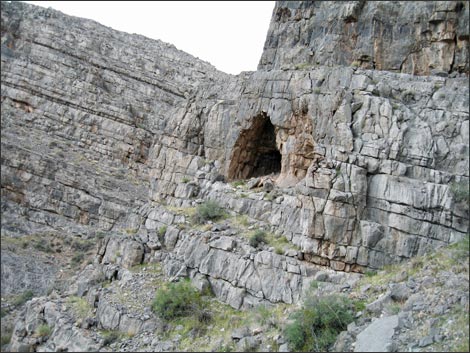 Carbonate rock layers in the Las Vegas Range |
Carbonate Rocks (Limestone and Dolomite). Around Las Vegas, carbonate rocks were formed in horizontal layers on the bottom of ancient seas some 600-250 million years ago [mya]. As particulate matter in the water column rained down, it built up layers that eventually solidified. The particulate matter was mostly plankton, precipitates, and suspended sediments that washed down rivers into the ocean, but also dead fish, seaweeds, shells, and similar detritus. The different layers in the carbonate rocks represent different environmental conditions as climate and water depth changed over time. For example, when sea levels dropped, it might have created warmer shallow-water conditions, and when sea level rose, it might have created colder deep-water conditions. Most of the mountains in southern Nevada are composed of carbonate rocks. Around Las Vegas, fossils are generally uncommon, but they can be locally abundant. Most of the fossiliferous material was formed from organic muck, and as such, appears as layers of amorphous dark material in the lighter limestone. In some places, large numbers of algae and sponge fossils can be found, but these too can appear a bit amorphous. Fossil corals, crinoids, brachiopods (clam-like creatures), and trilobites can be abundant in some areas. |
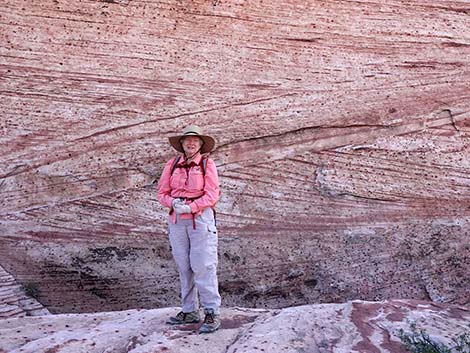 Sand dunes frozen by time at Red Rock Canyon NCA |
Sandstone. Around Las Vegas, the sandstone cliffs are formed from grains of sand that once were vast sand dunes covering much of the southwestern United States about 180-60 mya. Over time, the wind-blown sand grains were cemented together and became rock. Layers in the sandstone (cross bedding) often reveal the original sand dune structure, and the original sand grains can be scraped out of the rock. The red-and-white cliffs at Red Rock Canyon are sandstone, as are the red cliffs at Valley of Fire State Park and parts of Lake Mead. The red color in the cliffs is from rust (iron oxide), but the exact process by which the rust formed, plus where it formed (red rock) and did not form (white rock) are still questions the geologists are trying to figure out. It is a note that the sand in southern Nevada came from the erosion of the Appalachian Mountains. A large river, similar to the modern-day Mississippi River, carried sediments across the continent to the sea before the Rocky Mountains formed. Prevailing winds blew the sand from that ancient shoreline back onto the land creating a sand desert similar to the Sahara Desert of today. Over the millennia, the Appalachian Mountain sand solidified into our Red Rocks cliffs. |
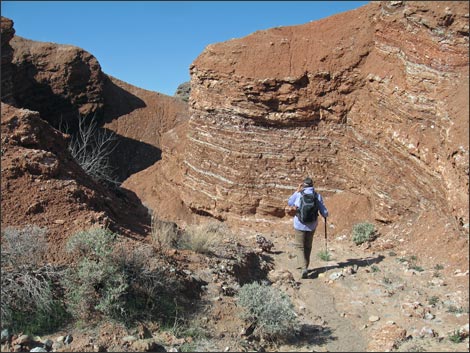 Layers of mud turned to mudstone |
Mudstone. Around Las Vegas, mudstones were formed from muds that settled in the bottom of ancient lakes or were formed in the delta of rivers flowing into the ocean. Depending on the size of the particles, mudstones can be coarse or fine grained, and depending on the cementing, mudstones can be soft or very hard. In many places around Las Vegas, the source of the "dirt" particles that formed the mud was volcanic ash. Mudstones near Lake Mead National Recreation Area often originated as volcanic ash, but mudstones around Red Rock Canyon National Conservation Area (below the sandstone) originated as river deposits. |
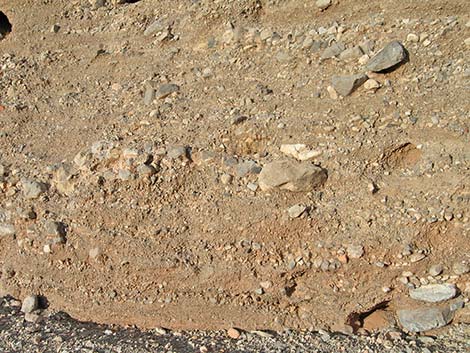 Conglomerate rocks on the edge of a wash |
Conglomerate. Conglomerate rocks usually are formed from cemented river deposits. The river deposits can be well or poorly sorted, but the original sands, gravels, and rocks are unaltered and remain clearly visible. Landslides can also produce rubble that can become conglomerate. Around Las Vegas, conglomerate rocks can be found in many places, but particularly nice examples form the canyon walls along lower Kyle Canyon Road, the main road to Mount Charleston in the Spring Mountains Recreation Area. Here, the towering canyon walls are highly sculpted and there are lots of hoodoos. |
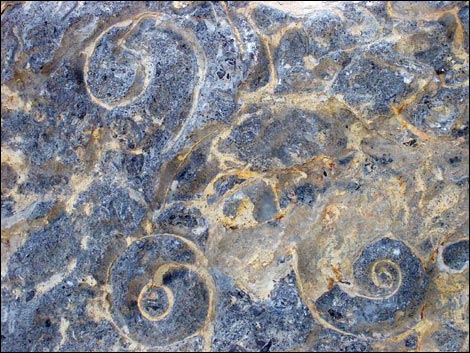 Snails died on the bottom of some ancient sea |
Fossils. Fossils are a record of the history of life on earth captured in stone. The breadth of time recorded in the rocks around Las Vegas spans about half of the history of the earth, and nearly the entire fossil record can be found here in sedimentary rocks. Around Las Vegas, fossils are most often found in limestone rocks (e.g., corals, shells), but sometimes are found in sandstone (dinosaur tracks), mudstone (petrified wood, animals tracks), and shale (trilobites). A great place to see corals, sponges, brachiopods (clam-like creatures), and scallop-like creatures is Fossil Canyon at Red Rock Canyon National Conservation Area. A bit more difficult to get to, Yucca Peak in the Desert National Wildlife Range also has some nice invertebrate fossils. Being protected areas, however, these are places to look and marvel, but leave the rock hammer at home and don't collect specimens. Trilobites can be collected at the base of Frenchman Mountain. |
| Rocks and Geology | Hiking Around Las Vegas | Glossary | Copyright, Conditions, Disclaimer | Home |